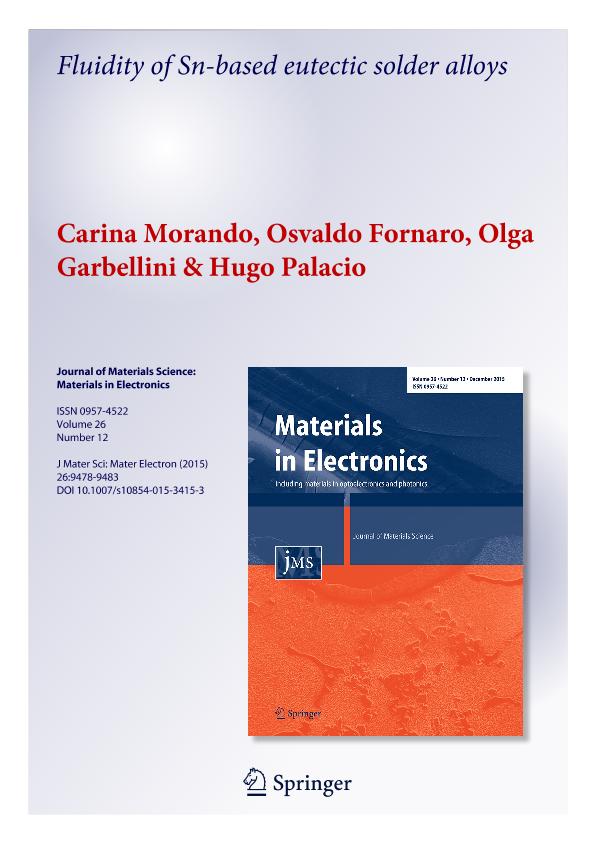Mostrar el registro sencillo del ítem
dc.contributor.author
Morando, Carina Noemi

dc.contributor.author
Fornaro, Osvaldo

dc.contributor.author
Garbellini, Olga
dc.contributor.author
Palacio, Hugo Anibal
dc.date.available
2016-04-15T20:59:06Z
dc.date.issued
2015-12
dc.identifier.citation
Morando, Carina Noemi; Fornaro, Osvaldo; Garbellini, Olga; Palacio, Hugo Anibal; Fluidity of Sn-based eutectic solder alloys; Springer; Journal Of Materials Science: Materials In Electronics; 26; 12; 12-2015; 9478-9483
dc.identifier.issn
0957-4522
dc.identifier.uri
http://hdl.handle.net/11336/5243
dc.description.abstract
Eutectic alloys have a great importance in both academic and technological point of view. As regard technological applications such as casting, welding andjoining, these systems offer lower melting point than the pure elements, and good fluidity. The fluidity length (LF) is known as the distance travelled by the liquid metal forced to flow through a channel of small cross section, until it is stopped by solidification. Physical variables associated with the process are: metallostatic pressure, heat extraction rate at the metal-mold interface, overheating of the liquid metal and the physico-chemical properties of the metal or alloy (latent heat of fusion, density, viscosity, surface tension and solidification mode). In general, pure metals and alloys of eutectic composition have the highest values of fluidity, whilst intermediate composition alloys with greater solidification range show lesser fluidity lengths.Taking into account that the chemical composition plays an important role in the fluidity length by its relationship with the resulting microstructure, the aim of this work is to obtain fluidity values of binary and ternary lead-free metallic alloys in order to determine the relationships between the morphology and the fluidity length, and consequently, the influence on binary and ternary pro-eutectic alloys. Fluidity tests were carried out in a linear fluidity device, using lead-free Sn based alloys, extensively used for important industrial applications. The samples were characterized using optical microscopy, scanning electron microscopy and energy dispersive X-ray microanalysis.Usually, fluidity length (LF) depends on solidification mode, latent heat of fusion of the alloy and the fluidity of the phases present in the microstructure.
dc.format
application/pdf
dc.language.iso
eng
dc.publisher
Springer

dc.rights
info:eu-repo/semantics/openAccess
dc.rights.uri
https://creativecommons.org/licenses/by-nc-sa/2.5/ar/
dc.subject
Fluidity
dc.subject
Sn Based Alloys
dc.subject
Eutectic Solder Alloys
dc.subject
Lfs
dc.subject.classification
Física de los Materiales Condensados

dc.subject.classification
Ciencias Físicas

dc.subject.classification
CIENCIAS NATURALES Y EXACTAS

dc.title
Fluidity of Sn-based eutectic solder alloys
dc.type
info:eu-repo/semantics/article
dc.type
info:ar-repo/semantics/artículo
dc.type
info:eu-repo/semantics/publishedVersion
dc.date.updated
2016-05-06 15:52:43.262787-03
dc.journal.volume
26
dc.journal.number
12
dc.journal.pagination
9478-9483
dc.journal.pais
Alemania

dc.journal.ciudad
Berlin
dc.description.fil
Fil: Morando, Carina Noemi. Consejo Nacional de Investigaciones Científicas y Técnicas. Centro Científico Tecnológico Tandil. Centro de Investigaciones en Física e Ingeniería del Centro de la Provincia de Buenos Aires; Argentina. Universidad Nacional del Centro de la Provincia de Buenos Aires. Facultad de Ciencias Exactas. Instituto de Física de Materiales; Argentina
dc.description.fil
Fil: Fornaro, Osvaldo. Consejo Nacional de Investigaciones Científicas y Técnicas. Centro Científico Tecnológico Tandil. Centro de Investigaciones en Física e Ingeniería del Centro de la Provincia de Buenos Aires; Argentina. Universidad Nacional del Centro de la Provincia de Buenos Aires. Facultad de Ciencias Exactas. Instituto de Física de Materiales; Argentina
dc.description.fil
Fil: Garbellini, Olga. Consejo Nacional de Investigaciones Científicas y Técnicas. Centro Científico Tecnológico Tandil. Centro de Investigaciones en Física e Ingeniería del Centro de la Provincia de Buenos Aires; Argentina. Universidad Nacional del Centro de la Provincia de Buenos Aires. Facultad de Ciencias Exactas. Instituto de Física de Materiales; Argentina. Provincia de Buenos Aires. Gobernación. Comisión de Investigaciones Científicas; Argentina
dc.description.fil
Fil: Palacio, Hugo Anibal. Consejo Nacional de Investigaciones Científicas y Técnicas. Centro Científico Tecnológico Tandil. Centro de Investigaciones en Física e Ingeniería del Centro de la Provincia de Buenos Aires; Argentina. Universidad Nacional del Centro de la Provincia de Buenos Aires. Facultad de Ciencias Exactas. Instituto de Física de Materiales; Argentina. Provincia de Buenos Aires. Gobernación. Comisión de Investigaciones Científicas; Argentina
dc.journal.title
Journal Of Materials Science: Materials In Electronics

dc.relation.alternativeid
info:eu-repo/semantics/altIdentifier/url/http://link.springer.com/article/10.1007%2Fs10854-015-3415-3
dc.relation.alternativeid
info:eu-repo/semantics/altIdentifier/doi/http://dx.doi.org/10.1007/s10854-015-3415-3
dc.relation.alternativeid
info:eu-repo/semantics/altIdentifier/doi/10.1007/s10854-015-3415-3
Archivos asociados
